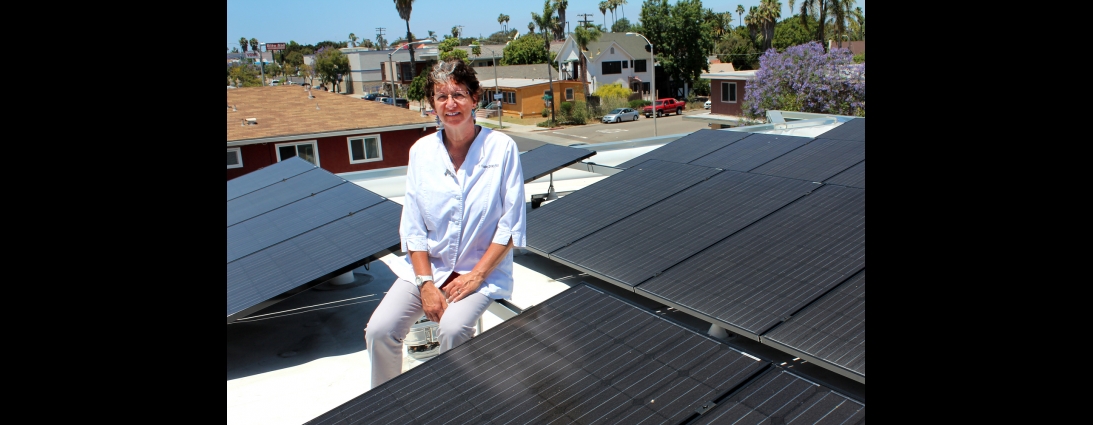

Installing solar power at the Kensington Veterinary Hospital on Adams Avenue seemed like a great way to combine long-held environmental values with a need for increased electricity, according to co-owner Dr. Patricia Ungar. Now that solar panels are producing a third of the pet center’s energy and providing up to a 40 percent utility bill savings, she’s also feeling a great deal of financial satisfaction.
“We found as our business grew over the past few years, we had to install more air conditioning and equipment that significantly increased energy costs while electrical rates continued to skyrocket,” Ungar said. “My husband and I wanted to cut back on our carbon footprint and find a long-term solution.”
Ungar and her husband Philip Linssen are among the small business owners nationwide joining in the solar power boom sparked over the past few years by plummeting prices for solar photovoltaic (PV) panels and a cornucopia of favorable tax credits, rebates and financing options.
According to the Solar Energy Industries Association, commercial installations increased by more than 40 percent during 2012-13, while the average price of a commercial PV installation decreased 30% since 2011. The average size of a commercial system has also decreased — an indication that smaller businesses are taking to solar.
“With the range of reasonable financing options, federal tax incentives and depreciation allowances, now is a great time for any company to consider going solar,” said CCSE Executive Director Len Hering, RADM, USN (ret). “There has never been a better, more beneficial time to invest in solar and secure the highest return on investment.”
Economics of commercial solar
According to James Reeve, owner of Newport Power in San Marcos, whose company installed Kensington Veterinary Hospital’s solar, PV systems are affordable for most any business that owns its building, has a moderate tax liability and spends more than a few hundred dollars a month on electricity usage.
“Solar has evolved into a financial wealth creator,” Reeve said. “You use your utility bill savings, a very substantial tax credit and depreciation in the first five years to finance your energy needs for the next 20 plus years, and increase your building’s value. If you have a tax liability, you are on track for solar.”
Tax codes governing solar investment are complex and change regularly, so the best advice is to work with an accountant to explore current programs and determine eligibility. A federal investment tax credit of 30 percent is secure for solar and other energy investments through 2016, however, unless legislation extends it, the ITC will reduce to 10% for projects that complete or start installation after Dec. 31, 2016. In recent years, an accelerated depreciation bonus allowed a company to write off 50 percent of solar costs in the first year with the remaining 50 percent depreciated over five years. This provision expired in 2014, but may return if the current Expiring Provisions Improvement Reform and Efficiency Act passes. Currently, solar qualifies for a five-year accelerated depreciation.
Breakdown of vet center costs
The Kensington Veterinary Hospital solar installation, completed in March, cost $63,440 for a 10.9-kilowatt PV system, which includes a new energy-efficient roof to hold the 42 PV panels. The owners paid cash, but with a federal tax credit of $18,560 and $26,960 in accelerated (bonus) depreciation along with a $3,250 state rebate, it left an out-of-pocket expense of about $14,670. The system is designed to provide approximately 33% of their annual energy usage and to shave off higher tier utility electricity costs.
“In the top tiers of electricity rates, San Diegans are paying some of the highest commercial utility rates in the nation, which obviously has a big impact on small businesses,” Reeve said. “Whereas SDG&E charges 15-25 cents per kilowatt-hour, with solar it runs about 6-9 cents.”
Financing and rebates available
Ungar and Linssen had the savings to cover the full solar investment, but many small business owners are not so well funded. Among the programs that help make solar affordable is PACE (property assessed clean energy) financing that offers low-interest, long-term, tax-deductible loans that are repaid through property taxes. These easy-to-qualify, no-money-down loans typically stay with the property if it is sold.
Although rebates for residential solar PV systems have run out, the California Solar Initiative program currently offers rebates to commercial customers. According to officials at the California Center for Sustainable Energy (CCSE) that serves as administrator for the program in the San Diego Gas & Electric territory, the rebate rates are at $0.25 per watt for commercial businesses and $0.90 for nontaxable entities.
An additional and substantial expense accompanying commercial solar is replacing the roof, which is required for nearly 90 percent of installations, according to Reeve. While roofing is typically considered a huge expenditure, Reeve says that by installing an energy-efficient cool roof made of a white material that reflects solar radiation, a customer can apply the federal investment tax credit and use PACE financing. A cool roof costs from $4-$6 per square foot, with $0.10 to $0.40 per square foot available for a tax credit.
Energy efficiency before solar
According to the solar experts at CCSE, making sure your business is energy efficient prior to installing solar is an essential first step. By reducing your overall energy use, you can reduce the size of the system you need, potentially saving thousands of dollars in up-front costs. The center offers advice for those interested in solar online, as well as rebate and contractor information.
